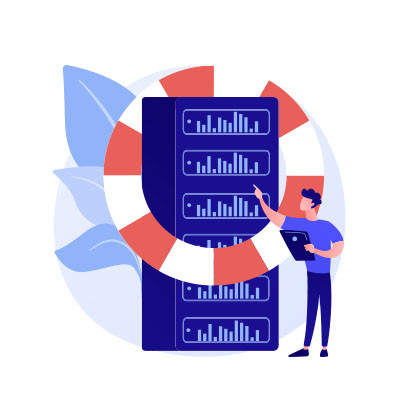No business ever wants to suffer a data loss disaster, but that doesn’t mean that it’s not coming for you at some point during your operations. You have to be careful and take calculated steps to minimize the impact of such an incident. In particular, you want to avoid losing these three types of data, for it could make recovery all but impossible if you don’t.
ImageSys LLC Blog
Data backup may not be at the forefront of your business’ technology list, but it needs to be a consideration. Like much of the technology we use for our businesses, backup is going through a lot of positive innovations at the moment. Let’s take a look at five things that are going to change the look of enterprise data redundancy.
Where there’s business, there’s the opportunity for losses. Even if you have your operations locked down, circumstances will always arise far beyond your control. We’re talking about the big ones, the devastating data loss incidents that grind your business to a halt and threaten its future. You can take action now to prevent these types of disasters from happening.
In today’s digital workplace, data backup and disaster recovery are critical components that demand strategic attention. We specialize in providing these services to SMBs, and we recognize the unique challenges that surface on a day-to-day level. Today, we’d like to go into the financial significance of investing in data backup and disaster recovery, with a particular focus on how our services can contribute to your company’s fiscal resilience.
Technological innovation can be exciting, but one topic that is decidedly unsexy with technology is data backup—at least, from an excitement point of view. More businesses are demanding greater data security and redundancy, which is in turn forcing developers to innovate and create better products that can give consumers and enterprises what they need. Let’s look at three of the more interesting features of these up-and-coming data backup solutions.
Uh oh. You were trying to be more secure and decided to set up multi-factor authentication. However, you’ve just discovered how important the other factors are when it comes to authenticating your identity. Yes, you’ve found yourself unable to access your means of authenticating yourself.
So…what do you do now?
Today’s businesses need a data backup, and just copying over data to another place every so often isn’t enough. Modern businesses need a comprehensive data recovery strategy in place to protect themselves from potential data loss in the event of a disaster. Let’s go through why it is critical to formulate one early on, and how to balance its maintenance with everything else your business demands.
We bet you’ve gone through your old files at some point to clean things up a bit by deleting files from your computer. What if we told you that deleting those files doesn’t actually delete them—at least not entirely? Let’s go over how you can securely delete your files for good while you go about replacing hardware or upgrading your technology systems.
You may have seen us use the term “redundant” on this blog often, and if you are not necessarily familiar with how it might be used in the context of business technology, we understand how you could misconstrue the word in a negative light. However, redundancy is one of the most important concepts to understand in business technology, and it’s key to your business’ continued success.
One of the most important solutions for a small business to implement is a data backup and disaster recovery system. It is a crucial element of any business continuity plan, yet many organizations fail to implement one in an appropriate manner. Let’s discuss three of the best reasons you must consider data backup and disaster recovery now before it’s too late.
Your business is not unique in the sense that it stores and transmits data during its day-to-day routines. Whether it’s financial information for your clients or employee records, it is more than likely that your business holds some kind of critical data that your operations rely on throughout the workday. Would your operations be able to recover from a sudden loss of data?
If you are a regular reader of this blog, or if you’ve seen our blogs on social media, you’ve probably seen that we discuss data backup regularly. Some of you have a dedicated data backup platform that routinely works to keep your business safe from data loss. Some of you don’t, and need one. Today, we’ll talk a little bit about why it’s such a big deal.
Know it or not, your business takes in and creates a lot of data. Most of this data, like most items and information, isn’t worth much. Some of it, however, is crucial to your business’ ability to operate. If a situation comes along where you are faced with the prospect of losing your data, it will be much better to have a backup plan in place than not.
I think we’ve made it pretty clear that your organization needs to back up its data. We’re continuously explaining that if you don’t back up your data, and have a plan to get it back quickly, you are really testing the foundations of your business. After all, in today’s business climate, data is a very big deal.
Data backup is an integral part of any business continuity strategy, but there are so many different parts to it that it’s not surprising some slip through the cracks if left unchecked. If you’re not taking measures to keep disasters from derailing operations, you could lose everything you’ve worked so hard to achieve. We’ll discuss the critical parts of a data backup and disaster recovery system, including how and why you should test your backups periodically.
A justifiable fear drives the data backup market. With all the emerging threats coming from the web, it’s hard to imagine that any company that uses the web for more than just email wouldn’t have a strategy in place to quickly replace lost data. A high percentage of small businesses fail as a result of data-loss incidents so when it comes to the continuity of your business, how you recover your data can be as important as protecting it in the first place.
If you subscribe to Murphy’s Law, you understand why it is so crucial for every business to have a backup solution planned, put into place, and prepared for the worst. However, not every business should go about putting their backup strategy together in the same way. After all, their needs will be different, based on their industry, the data they store, and a variety of other factors.



















